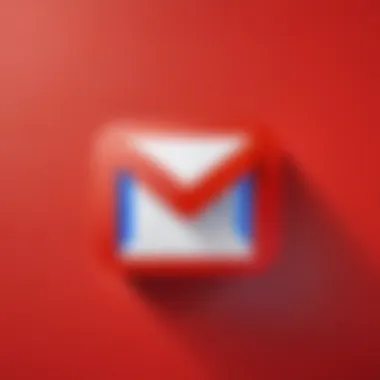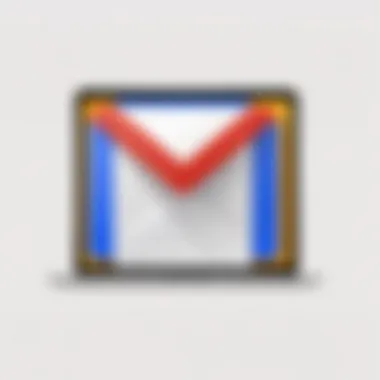Step-by-Step Guide to Creating a Free Gmail Account


Intro
In an age where communication twists and turns through the vast digital landscape, creating a Gmail account stands as a fundamental step toward establishing a foothold in today’s interconnected world. Gmail has evolved since its inception, not just as a platform for sending and receiving emails, but also as a powerful tool for organizing information, managing contacts, and enhancing productivity. With features like labels, powerful search capabilities, and seamless integration with various applications, it’s no wonder that millions opt for Gmail.
However, setting up a Gmail account isn’t just about convenience; it’s also about security. The increasing array of cyber threats lurking in the shadows means that how we navigate our online existence must be taken seriously. This guide will not only walk you through the steps of creating a free Gmail account but will also delve into vital aspects surrounding cybersecurity considerations, helping to ensure that your digital journey begins on a secure note.
As we explore the process of account creation, we will address key themes including the importance of strong password management, levels of protection offered by Gmail, and what you can do to maintain your privacy while using such services.
Cybersecurity Threats and Trends
In today's digital ecosystem, the landscape of cybersecurity is ever-evolving. Understanding the threats that one may face while navigating online is key to safeguarding personal and sensitive information.
Notable cybersecurity threats in the digital landscape
One prevalent threat comes in the form of phishing attacks. Attackers often design deceptive emails that mimic legitimate sources, tricking unsuspecting users into divulging personal information. Just the other day, I received one that looked exactly like a Google notification—only to find out it was a scam.
- Yet another worrisome threat is ransomware. Once a system is infected, the data becomes inaccessible unless a hefty ransom is paid. Businesses are often prime targets here.
Emerging trends in cyber attacks and vulnerabilities
Recent years have seen a rise in the use of Artificial Intelligence by cybercriminals to enhance the efficiency of their attacks. AI can help craft more convincing phishing messages or even discover vulnerabilities in systems much quicker than before.
Impact of cyber threats on individuals and businesses
These threats can wreak havoc on both personal lives and business operations. For individuals, a single attack might lead to identity theft, loss of financial resources, or even emotional distress. Businesses face not only financial implications but also the potential for loss of customer trust, something that can take years to rebuild.
Best Practices for Cybersecurity
To avoid falling prey to these threats, it’s essential to adopt best practices for staying safe online. Here are some key methods:
- Importance of strong password management: Always create complex passwords with a mix of letters, numbers, and symbols. It’s wise to avoid using the same password across multiple platforms.
- Implementing multi-factor authentication for enhanced security: Adding this layer of protection reduces the risk of unauthorized access. If someone were to steal your password, they’d still need a second form of verification—making it much harder for them to break in.
- Regular software updates and patches for protection: Software companies frequently release updates to fix vulnerabilities. Not keeping your software updated is like leaving the front door open.
- Secure online browsing habits and email practices: Think before clicking. If an email looks fishy, it probably is. Always verify the sender's information before opening any attachments or links.
Privacy and Data Protection
When creating a Gmail account, it’s not just about convenience; your privacy must also be a priority. Understanding how to protect your information is crucial.
Importance of data encryption for privacy
Data encryption scrambles your information, making it unreadable without the right key. This is especially important when using public Wi-Fi, as hackers often lurk on these networks looking for unprotected data.
Risks associated with sharing personal information online
Each time information is shared online, it possesses the potential to be misused. A little caution can go a long way—ask yourself if that detail is truly necessary to share.
Strategies for safeguarding sensitive data and personal details
Utilizing tools like password managers can help maintain security of your passwords and personal data. Additionally, regularly monitoring your online presence is a smart way to catch any anomalies before they escalate.
Security Technologies and Tools
Familiarizing yourself with security technologies can provide an extra layer of defense when creating a Gmail account.
Overview of key cybersecurity tools and software
Several tools can help monitor and improve your online security. Firewalls, for instance, act as a barrier between your network and potential threats from the outside.
Benefits of using antivirus programs and firewalls
Antivirus programs work like a watchdog, scanning for known threats and preventing malware infections. Firewalls help block unauthorized access to your network. Together, they fortify your digital defenses.
Application of Virtual Private Networks (VPNs) for secure data transmission
A VPN establishes a secure and encrypted connection over a less secure network. This is valuable when connecting over public Wi-Fi, as it conceals your IP address and makes it difficult for prying eyes to monitor your online activity.
Cybersecurity Awareness and Education
It is no longer enough to possess just the tools for protection; understanding how to use them effectively is crucial. Awareness can be your best defense against cyber threats.
Educating individuals on recognizing phishing attempts
Phishing is the most common form of cyber threat. Familiarizing yourself with telltale signs, such as poor grammar, generic greetings, or mismatched email domains, can save you from falling victim to malicious attempts.
Promoting cybersecurity awareness in the digital age
Advocating for a culture of cybersecurity awareness can be a game-changer. People should feel empowered to ask questions and seek knowledge about their online safety.
Resources for learning about cybersecurity fundamentals
Several websites offer free courses and articles on cybersecurity basics, including Wikipedia and Britannica.
Preamble to Gmail
Gmail has transformed the way we handle electronic communication. With its inception in 2004, it wasn’t just another email client; it marked a watershed moment in the evolution of digital conversations. Understanding the importance of Gmail in today’s fast-paced world is crucial, especially for professionals and students who rely on efficient, reliable communications.


The significance of Gmail is not just in its capabilities but also in how it fits into the broader landscape of email services. In this section, we will explore its evolution, the compelling reasons to choose Gmail, and the features that cater to diverse users.
The Evolution of Email Services
Email services have undergone significant changes since their origins in the early 1970s, where it was primarily a text-based service for sending messages over ARPANET. By the turn of the millennium, several platforms emerged, allowing users to communicate with attachments and rich text formatting. However, many had their limitations, like cumbersome storage limitations or unrefined user interfaces.
When Gmail arrived on the scene, it brought about a radical shift. It offered a generous storage capacity that far exceeded its competitors at that time, which often meant worrying about inbox limits. The introduction of threading email conversations and the then-novel approach of categorizing messages transformed how users interacted with their inboxes. Features that prioritize an organized and user-friendly experience paved the way for more intuitive communication.
This evolution reflects a broader trend in technology: the need for efficient and reliable communication tools to cope with rising expectations and information overload.
Why Choose Gmail?
Choosing Gmail goes beyond just enjoying a free service. It’s about embracing a robust platform prepped with features that enhance productivity. Here are a few critical reasons:
- Generous Storage: Gmail provides 15 GB of free storage, shared across Google services. This enables users to keep their emails without overstuffing their inbox.
- Seamless Integration: If you’re diving into Google’s ecosystem, Gmail integrates beautifully with other tools like Google Drive, Calendar, and Docs. It turns your email platform into a hub for better productivity.
- Priority Organization: With features like tabs for promotions, social updates, and more, managing different types of emails becomes a walk in the park. You can flag important messages or even snooze them for later.
- Enhanced Security: Gmail is fortified with safety measures like spam filtering and built-in phishing protection. Plus, the option for two-factor authentication adds an extra layer of security for peace of mind.
In the realm of email, the user experience can make or break daily operations. Gmail not only eases communication but also supports organizational and collaborative efforts. Understanding these nuances helps users make informed choices about their digital communication needs.
Understanding Gmail Features
When diving into the realm of digital communication, it's crucial to grasp the features that Gmail offers. Knowing these functionalities not only enhances the user experience but also ensures you’re leveraging all that this email platform has to offer. In a world where digital communication is constant, understanding features like storage capacity, integration with other Google services, user interface, and search capabilities can empower users from all backgrounds.
Storage Capacity
Gmail provides users with 15 GB of free storage shared across Google Drive, Gmail, and Google Photos. This sizeable allotment allows individuals to manage emails, attachments, and other important documents without a hitch. Think about it, just a few years ago, limits were much stricter. This ample space makes Gmail a handy choice for both personal and professional use.
For larger needs, Google offers different plans through Google One, which expands storage options significantly, suitable for anyone needing that extra legroom. You can always start with the free option and upgrade as necessary. This flexibility supports a growing digital footprint without the fear of hitting a wall.
Integration with Google Services
One of Gmail's strongest selling points is its integration with various Google services. This includes seamless connectivity with Google Calendar, Google Drive, and Google Meet, among others. Users can switch between emails, appointments, and files as easily as a knife through butter. For professionals constantly juggling tasks, this interconnectedness is invaluable.
In practice, scheduling a meeting on Google Calendar can be done right from an email, or you can save attachments straight to Google Drive with a couple of clicks. This fluidity turns Gmail into more than just an email client; it becomes a bridge to a wider ecosystem designed for productivity. With everything in one place, users can ditch the endless app switching that often hampers efficiency.
User-Friendly Interface
Navigating through Gmail’s interface can feel like a walk in the park. The layout is designed for ease, with a clean look that avoids clutter. Key functionalities are prominently displayed, allowing users to understand and utilize them quickly. A user can easily locate the inbox, categorized tabs, and even access settings with minimal stress.
The search bar at the top is particularly well-designed, supporting both basic and advanced queries. For example, users can search for attachments or emails from specific dates or contacts without knowing exact titles. Overall, a user-friendly approach ensures that even someone who is not tech-savvy can dive into their inbox with confidence.
Advanced Search Functionality
Gmail's advanced search features are a gem for those who feel overwhelmed with the volume of emails today. The ability to refine searches with various parameters—such as filtering by sender, subject, date, and keywords—shifts the experience from searching for a needle in a haystack to finding just the right message swiftly.
Consider this: a student might need to sift through hundreds of emails for a specific project. With Gmail's tools, they could effortlessly narrow down results and locate what they need, rather than scrolling endlessly. This advanced search capability not only saves time but also boosts productivity, making it a powerful feature in both academic and professional settings.
"A well-defined searching capability is a necessity in today's fast-paced digital communication landscape."
Overall, understanding these features transforms the way users interact with their email accounts. By recognizing the storage potential, integration capabilities, intuitive interface, and advanced search options, individuals can tailor their Gmail experience to meet personal and professional demands effectively.
Steps to Create a Free Gmail Account
Creating a Gmail account is the first step towards enjoying a seamless email experience, which has become essential in today’s digital landscape. The process is straightforward, but it comes laden with important decisions and considerations that can greatly impact both user experience and security. In this section, we will unravel the intricacies involved in establishing your very own Gmail account, covering everything from navigating to the sign-up page to filling out necessary registration fields and confirming your identity.
Navigating to the Gmail Sign-Up Page
To start with, you need to get to the Gmail sign-up page. Simply put, your journey begins here—this is your launching pad into the world of Google. You can easily find this page by conducting a quick search online or by directly typing "Gmail sign up" into your browser’s address bar. Once there, you will be greeted by a clean interface that welcomes you with open arms.
Why is this step crucial? Missing this as the foundational move could lead you on a wild goose chase, stressing over the wrong link. So, make sure you are on the right page by double-checking the URL. Don’t make this more complicated than it needs to be!
Filling Out the Registration Form
Once on the sign-up page, it’s time to roll up your sleeves and begin filling out the registration form. This part might seem a bit tedious, but hang in there—it’s worth it!
Choosing a Unique Username
A key aspect of creating a Gmail account is selecting a unique username. This isn’t just some random task; your username will act as a digital identity in the vast sea of the internet. A good username should be memorable but still professional if you plan to use Gmail for work.
Here’s a pro-tip: consider using a combination of your initials and some numbers related to you, like your birth year or a favorite number. This characteristic of having a unique identifier isn’t just beneficial; it also enhances your digital footprint in a world where uniqueness is often celebrated.
The main advantage of a unique username is that it helps avoid conflicts—nobody enjoys getting locked out because somebody else snagged their preferred choice before they did!
Setting a Strong Password
Next up is setting a strong password. This is the key to your castle, so don’t take it lightly. A strong password typically contains a combination of letters, numbers, and symbols, making it harder for unauthorized individuals to access your account.
A solid password contributes significantly to the overall goal of safeguarding your sensitive information. One mistake many people make is opting for passwords that are too simple or too similar to previous passwords. Avoid those common pitfalls! Instead, aim for a password that is complex yet something you can remember.
A unique feature of strong passwords is that they provide you with an added layer of security, particularly when combined with other security measures such as two-factor authentication.
Verifying Your Phone Number
Once you’ve completed the registration form, one of the next steps involves verifying your phone number. This requires you to enter your mobile number, which helps enhance your account’s security. You’ll receive a text message with a verification code that you’ll need to enter on the website to confirm that you own the number.


The importance of this step shouldn’t be underestimated. It functions both as a measure to keep unauthorized users at bay and as an avenue for Google to assist you in account recovery if you ever face any troubles accessing your account.
Completing Additional Information
Finally, you will need to complete a few additional bits of information that are often overlooked but crucial for a comprehensive setup.
Recovery Email
A recovery email is as vital as your primary email. This acts as a backup mechanism should you forget your password or get locked out of your account. By providing a recovery email, you make it easier to regain access to your account, showing that preparation truly is key. It’s a beneficial choice because even if you misplace your primary login information, you have a direct line to restore your access.
However, keep in mind that this recovery email should also be secure—using a different email provider can be helpful if you want to ensure your Gmail isn’t the only point of vulnerability.
Date of Birth and Gender
While it might seem these details are unnecessary, providing your date of birth and gender can help Gmail tailor your experience. This information can be used to improve features specifically designed for you. Plus, ensuring the age is correct can also steer clear of minor hassles later on, like age-restricted content.
Keep in mind that while this information is not strictly necessary, it shows how you can customize your digital interaction and enhance your overall experience with Gmail.
Account Security Considerations
Setting up a free Gmail account, while being quite straightforward, involves far more than simply entering your details and clicking ‘Create Account’. One crucial aspect that stands out in this process is the emphasis on account security. With the increasing amount of personal data shared online, it's imperative to consider the security measures available to protect that information. After all, the last thing anyone wants is to lose access to their account or, worse yet, have their information compromised.
A few years ago, cyberattacks were somewhat more rare, but those days are gone. Now, it seems like there's news about yet another breach every week. The truth is, we have to be proactive about our digital safety. Gmail offers various features that help users enhance their security, making the account setup not just a mere formality but an essential step in safeguarding one’s personal information.
Importance of Two-Factor Authentication
One of the best ways to add an extra layer of security to your Gmail account is through Two-Factor Authentication (2FA). This procedure requires you to provide two forms of identification before you can access your account. Usually, this combines something you know, like your password, along with something you have, such as your mobile phone.
Here’s why enabling 2FA is important:
- It significantly reduces the risk of unauthorized access. Even if someone steals your password, they won't be able to log in without your second form of identification.
- It adds a hurdle for potential hackers. A password alone is often not enough these days, and adding another step can deter even the most determined attackers.
- Makes recovery easier. If you ever forget your password, 2FA offers an additional safety net, allowing you to regain access more smoothly.
To enable Two-Factor Authentication:
- Go to your Google Account settings.
- Navigate to the Security section.
- Follow the prompts to set up 2FA. You can choose to receive codes via text message or phone app.
Note: Always use trusted devices for receiving authentication codes. Public Wi-Fi can expose you to risks.
Setting Up Security Questions
While Two-Factor Authentication is a robust solution for protecting your account, setting up security questions offers another line of defense, albeit a slightly less common one. These are special questions that you can set up during the account creation process, or update later in your security settings. Certain things to keep in mind include:
- Choose answers that only you would know. It’s not just about picking a question; it’s about ensuring its answer isn’t easily guessable by others.
- Avoid answers that could be publicly available. For example, rather than using your hometown, maybe pick an obscure detail from your past.
- Regularly update your security questions. If you suspect them to be compromised or simply haven’t thought about them in a while, it might be worth revisiting.
Overall, setting these security questions, along with employing 2FA, makes it much harder for anyone except you to access your Gmail account, providing peace of mind as you navigate the digital landscape.
Personalizing Your Gmail Experience
In a world brimming with digital communication tools, Gmail stands apart not just for its reliability, but also for its flexibility in personalization. This aspect of Gmail is particularly vital, as it helps users tailor their experience to better match their unique needs and preferences. By customizing settings and features, individuals can create an environment that enhances productivity, boosts email management efficiency, and fosters a sense of ownership over their accounts.
Personalizing your Gmail is not merely about aesthetics; it's about creating a communication experience that's streamlined and functional. Enhancing the interface allows for smoother navigation, while tailored settings can assist in managing overflowing inboxes. This customization offers users not just utility, but also a comfort that reflects their working style and personality.
Choosing a Theme
One of the first steps in personalizing your Gmail experience is selecting a theme that resonates with your style. Google offers a variety of themes that range from serene landscapes to vibrant patterns, providing users with a chance to infuse a bit of their identity into their workspace. Choosing a theme can impact how you perceive and interact with your inbox daily.
To change the theme, simply follow these steps:
- Open Gmail and click on the Settings gear icon in the upper right corner.
- Select See all settings from the dropdown.
- Navigate to the Themes tab.
- Explore the options and click on the one that speaks to you.
It’s surprising how a simple tweak like changing a theme can make the often monotonous task of sorting through emails feel a bit more enjoyable. Personal preference plays a key role here; for instance, a professional might lean towards subtle colors, while a creative might favor a bold design. It’s a reflection of the individual's character, making the interface less of a chore and more of a tailored space.
Organizing Your Inbox with Labels
Once the theme is set, the next step is organizing the inbox through labels. Labels in Gmail function like folders but with a twist—they allow you to categorize emails without traditional limitations. Unlike folders, which can only house a single location for an email, labels enable you to assign multiple tags to an email. This feature can dramatically enhance how you manage your workflow.
To create and manage labels:
- In Gmail, click on the More option on the left sidebar.
- Select Create new label.
- Name your label and click Create.
Once your labels are established, you can drag and drop emails into the appropriate categories or even apply labels during the email composition process. This method not only declutters your inbox but also allows for quick access to important messages based on the context. Here’s a practical way to approach it:
- Work: For emails related to projects and tasks
- Personal: For correspondence with friends and family
- Invoices: For tracking expenses and bills
By using labels effectively, you streamline the way you handle emails, making it easier to find what you need without the time-consuming hunt through a congested inbox.
"A well-organized inbox is the key to a smoother workflow. Labels in Gmail make it possible to stay on top of essential communications effortlessly."
Managing Your Gmail Account
Managing a Gmail account is more than just sending and receiving messages. It’s akin to steering a ship through both calm and stormy seas. Knowing how to navigate your account effectively optimizes your email communication and ensures that everything runs smoothly.
Your Gmail account isn't just a mailbox; it's a powerhouse of organizational tools and security features that can enhance your digital life. By understanding how to manage your account, users can adjust settings to fit their unique needs and preferences. This section delves into key components that keep your Gmail experience efficient.


Accessing Settings
To start making the most out of your Gmail account, you first need to access the settings. This can feel a bit like opening the hood of a car to see what’s under there; it can be intimidating at first, but once you're in, it’s clear how everything functions.
Account Preferences
The Account Preferences section is a hidden gem for users wanting to customize their email experience. It allows you to modify your personal information, like your display name, recovery options, and even the language settings. This is particularly important for users who may not be English speakers or who want to present themselves differently in their communications.
One key characteristic of the Account Preferences is its flexibility and ease of use. Users can make changes without needing in-depth technical knowledge, making it a popular choice for individuals who might not consider themselves tech-savvy.
Among its unique features is the option to manage linked accounts. If you frequently handle emails from various other providers, linking them to your Gmail can streamline your communication process. However, this could also create a mess if not managed properly, as it may become hard to track what emails belong where.
Mail Settings
Adjacent to Account Preferences, the Mail Settings section is where the nitty-gritty work happens. This space is designed for optimizing how you interact with incoming and outgoing messages. Here, individuals can adjust filters, set up forwarding options, and customize their inbox layout.
The strength of Mail Settings lies in its robustness. For example, built-in filtering lets you keep your inbox tidy by automatically sorting incoming emails into categories such as promotions, updates, or primary. This feature doesn’t only help in maintaining organization but can also minimize distractions, allowing users to focus on what’s important.
However, some may find the sheer number of options overwhelming, particularly new users. With so many buttons and toggles, it’s easy to lose track of what adjustments have been made. It can become a double-edged sword in terms of functionality versus simplicity.
Understanding Security Settings
When it comes to managing your Gmail account, the Understanding Security Settings section can be thought of as the fortress around your castle. These settings are crucial for protecting your personal information and ensuring that your communications remain private.
Here, you will find options for enabling two-factor authentication, managing devices with access to your account, and setting recovery options. Ignoring this aspect could leave your account vulnerable, making it worthwhile to revisit these settings regularly. Not just for beginners but for anyone who uses email as their bread and butter in the digital landscape.
Troubleshooting Common Issues
Creating a Gmail account can be smooth sailing, as long as you know how to navigate the occasional bumps on the road. Understanding how to troubleshoot common issues is absolutely crucial. It helps users regain access to their accounts swiftly and ensures a secure email experience. After all, even the best systems can stumble from time to time.
Resetting Your Password
Password management ranks near the top of the list when handling online accounts. Sometimes, a user may feel like they’ve hit a wall trying to recall their password. No sweat, though! Resetting a forgotten password is a simple process. Here’s how it goes:
- Go to the Gmail Sign-In page: Enter your email address. If you forget your password, click "Forgot password?".
- Follow the prompts: Google will lead you through a series of steps to verify your identity.
- Choose a verification method: You might get a prompt to receive a verification code via your recovery email or phone number. Make sure you've access to them.
- Create a new password: Once your identity is confirmed, you can set a new password. It’s best to make it a mix of letters, numbers, and symbols to keep it robust.
A strong password acts as your first line of defense. Always avoid common phrases that a hacker might guess.
Recovering a Hacked Account
Nothing is more concerning than realizing your account has been compromised. If you suspect foul play or notice unusual account activity, immediate action may prevent further issues. Here’s a step-by-step plan:
- Attempt to log in: If you can still access your account, change your password right away.
- Check for suspicious activity: Look for any changes in settings, such as altered recovery options or unknown devices linked to your account.
- Use Google’s recovery page: If you can't login, head straight to the Google Account Recovery page. You will need to verify your identity using recovery options you set previously.
- Secure your account: Once access is restored, take some time to enable two-factor authentication. This extra step can be a game-changer in preventing future breaches.
Remember, time is of the essence when dealing with a hacked account. The quicker you act, the better chance you have at keeping your email safe.
Beyond just restoring access, it’s essential to review and enhance your overall security measures to avoid repeating the same mistake. Regularly updating passwords and being vigilant of phishing attempts can go a long way in safeguarding your digital life.
The Future of Email Communication
In the digital world, email remains a cornerstone of communication, yet it is evolving at a pace that can be hard to keep up with. Understanding the future of email is crucial, particularly for users who rely on platforms like Gmail for both personal and professional correspondence. As technology advances, so do user needs and expectations, driving trends that shape how email services operate. Being aware of these trends and features can help users make informed decisions and enhance their overall email experience.
Emerging Trends in Email Services
The email landscape is not static. It adjusts to new technologies, security demands, and user preferences. Here are some pivotal trends that are shaping the future of email services:
- AI Integration: From sorting emails to predicting responses, artificial intelligence is making its mark in email management. Gmail, for instance, uses AI to filter out spam and prioritize important messages, allowing users to focus on what truly matters.
- Enhanced Security Features: In light of increasing cyber threats, Gmail is stepping up its game with features like end-to-end encryption, robust spam filters, and advanced phishing detection. These enhanced security measures ensure that sensitive information remains safe from prying eyes.
- Collaboration Tools: Email is now often intertwined with productivity tools. The integration of services like Google Meet and Google Drive within Gmail signifies a shift towards using email as part of a broader collaborative framework, streamlining communication for teams and individuals alike.
- Personalization: Users are seeking more personalized experiences, and email service providers are adapting. Features such as customizable fonts, layout settings, and tailored notifications allow users to craft email environments that suit their preferences.
Evaluating New Features
As Gmail continues to adapt, assessing new features becomes paramount. Here’s a look at some noteworthy additions that users should be aware of:
- Smart Compose: This feature leverages machine learning to help users write emails more efficiently. By suggesting phrases based on your writing style, it speeds up the email creation process without sacrificing personalization.
- Snooze Functionality: Users can temporarily remove emails from their inbox and have them reappear at a specified time. This helps to declutter inboxes while ensuring that important emails are not forgotten.
- Confidential Mode: With this feature, users can send emails that automatically expire after a specified time. This is particularly useful for sharing sensitive information securely.
The evolution of email services signals a transition towards more intelligent and user-centric communication tools. Understanding these changes can ensure users remain ahead of the curve.
In summary, the future of email is about security, collaboration, and personalization. As Gmail rolls out new features, users need to evaluate these changes critically to harness the full potential of their email communication.
Ending
As we draw the curtain on this exploration of Gmail, understanding its significance in the digital age becomes paramount. This article has highlighted not just the steps to create a free Gmail account, but has also underscored the myriad benefits that accompany it. The importance of having a Gmail account goes beyond mere convenience; it’s about fostering communication in today’s fast-paced world.
Summarizing the Benefits of Gmail
Gmail isn't just any email service; it's a versatile tool that can greatly enhance your online experience. Here are some key benefits:
- Robust Storage: With ample storage capacity, users can rest easy knowing that their emails and attachments are safe without constantly worrying about space constraints.
- Integration: Gmail seamlessly integrates with various Google services. This means that whether it's Drive, Docs, or Calendar, users can collaborate and manage their tasks in one cohesive environment.
- User-Friendly Interface: Many find Gmail’s interface easy to navigate. It’s designed with the user in mind, providing easy access to essential functions and settings.
- Advanced Features: From powerful search functionalities to customizable inbox management, Gmail offers tools that cater to both basic and advanced users alike.
"In the realm of communication, having a reliable tool is crucial. Gmail checks all the boxes for users of all backgrounds."
There's also the added layer of security. Utilizing two-factor authentication and various security settings helps users maintain the integrity of their data and communications.
Encouraging Users to Explore Further
While this guide walks you through setting up your Gmail account, the journey doesn't end here. Explore the vast functionalities available; each feature is designed to enhance your productivity and streamline communication.
- Try Out Additional Features: Features like Google Meet, Google Chat, and various third-party applications are available at your disposal, ready to be utilized for both personal and professional communication.
- Stay Updated on New Features: Gmail is continually evolving. Regularly check in on updates or new functionalities that could simplify your workflows.
- Engage with Online Communities: Platforms like Reddit offer active communities where users share tips and tricks. Engaging with these communities can unveil methods you might not have thought of before.
In summary, embracing Gmail can significantly affect your digital communication practices. It remains a critical player in how we connect with one another, and it’s worth diving into its full feature set.







